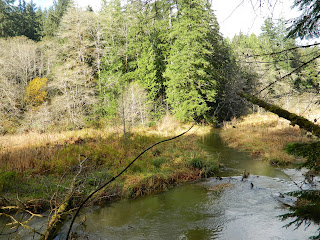When looking for a pretty, low-land hike for autumn, don't discount Lake Sylvia State Park. This is the second time I've visited the park, the first being via kayak a few Thanksgivings ago. There is a trail that wraps around the lake, hugging the shoreline and offering water views, autumn colors, and, if you're lucky, some waterfowl taking a break on their journey south.
 My cousin's granddaughter wanted my sister to shoot her senior portraits, and the venue chosen was Lake Sylvia. I tagged along as my sister's assistant, looking forward to spending time with family and hiking the loop trail. The forecast was calling for mostly cloudy which, as any true Northwestern resident knows, could mean just about anything goes. Nevertheless, we threw on our jackets, grabbed Heidi's photo gear and headed outside. We hit a rain squall on the way, but the weather broke and looked promising by the time everyone arrived, so off we headed.
My cousin's granddaughter wanted my sister to shoot her senior portraits, and the venue chosen was Lake Sylvia. I tagged along as my sister's assistant, looking forward to spending time with family and hiking the loop trail. The forecast was calling for mostly cloudy which, as any true Northwestern resident knows, could mean just about anything goes. Nevertheless, we threw on our jackets, grabbed Heidi's photo gear and headed outside. We hit a rain squall on the way, but the weather broke and looked promising by the time everyone arrived, so off we headed. Not in a big hurry, we followed the trail at a more leisurely pace, which was nice. There are benches placed along the trail where visitors can sit to enjoy the serenity, soak in the colors or do a little bird-watching. We took pause at a few where the setting & lighting was perfect for portrait shots. The colors, though waning, were remarkable, matched in beauty only by the subject of the portraits. I carried a deflector shield with me and had fun bouncing light off things as we walked. The rain-swollen lake spilled over its banks, flooding a few hundred feet of trail with 6 inches or so of water. Our family isn't easily dissuaded, so we rolled up our pant legs and splashed our way through. Our feet may have been soaked, but we were having fun!
 As the trail wrapped around the end of the lake, we encountered our only elevation gain - the trail quickly climbed about 3 stories. Just before dropping again and delivering us back to the lakeshore, we were treated to an adorable covered bridge spanning a small stream. Heidi shot a series of photos here, giving the rest of us time to more thoroughly appreciate the beauty of our surroundings. Autumn yellows, golds and browns blended with the darkness of the evergreens, standing in contrast to the deep blue of the lake. As I leaned against the railing, gazing out through the trees, a small flock of Canadian Geese broke the glassy surface of the water as they swam past. Above us, birds chittered and flitted about. Below us a plethora of fungi grew profusely. It was enchanting.
As the trail wrapped around the end of the lake, we encountered our only elevation gain - the trail quickly climbed about 3 stories. Just before dropping again and delivering us back to the lakeshore, we were treated to an adorable covered bridge spanning a small stream. Heidi shot a series of photos here, giving the rest of us time to more thoroughly appreciate the beauty of our surroundings. Autumn yellows, golds and browns blended with the darkness of the evergreens, standing in contrast to the deep blue of the lake. As I leaned against the railing, gazing out through the trees, a small flock of Canadian Geese broke the glassy surface of the water as they swam past. Above us, birds chittered and flitted about. Below us a plethora of fungi grew profusely. It was enchanting. Another stop was made at a picturesque location on the bank of the lake where a few more shots were taken, then we finished our day back at our cars.
I always enjoy watching my sister work, especially when it means time can be shared on the trail. We were blessed with good weather on a weekend with a stormy forecast, and the opportunity to spend time with family ... and Lake Sylvia was the perfect host.
Challenge Hike 52 of 52.
Distance: 5 miles
Elevation gain: 30'
Max Elevation Achieved: 170'











